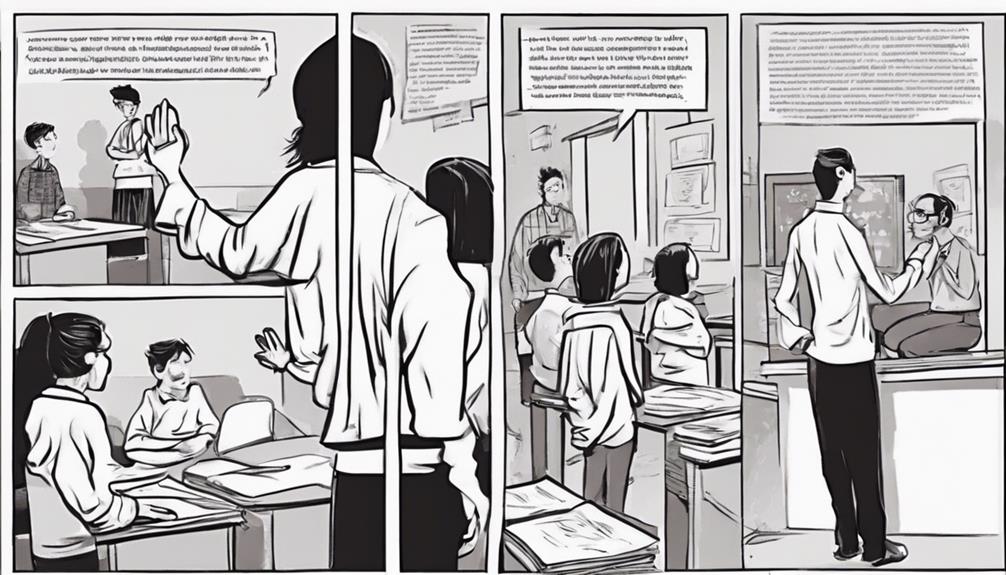In the bustling world of education, mastering stress management techniques is a game-changer for teachers. Harness the power of the Four Ss Approach – Stop, Smile, Sleep, Send – to navigate stress gracefully. Pause, reflect, and smile – even research backs up the magic of a grin in reducing stress. Prioritize adequate sleep for better emotional balance and decision-making. Embrace the art of sending responses only when emotions are stable to ward off conflicts. Intrigued? Discover more practical steps, frustration management tactics, communication strategies, community engagement perks, and wellbeing resources ahead.
Key Takeaways
- Practice the Four Ss Approach: Stop, smile, sleep, and send for effective stress management.
- Implement practical frustration management steps, respond only when emotionally stable.
- Enhance communication strategies to reduce frustration and foster a positive work environment.
- Engage with the teaching community for support, connections, and professional development.
- Access resources like mental health hotlines, wellness programs, and online communities for teacher wellbeing.
Four Ss Approach for Stress Management

When addressing stress management techniques for teachers, the Four Ss Approach provides a structured method to navigate and mitigate feelings of frustration and overwhelm.
This approach includes four key steps: Stop, Smile, Sleep, and Send.
First, stopping to pause and reflect on emotions is essential in managing stress effectively. Research shows that a simple smile can have a significant impact on improving mood and reducing stress levels.
Additionally, ensuring adequate sleep and rest allows for better emotional regulation and decision-making.
Finally, sending responses only when emotionally stable helps prevent unnecessary conflicts and negative consequences.
Practical Steps for Frustration Management

In implementing practical steps for managing frustration, teachers can proactively address challenges and maintain a positive working environment. By addressing issues in a positive and solution-focused manner, educators can navigate frustrations effectively.
Responding only when emotionally stable guarantees thoughtful and constructive interactions. Acquiring new skills or seeking help from colleagues for behavior management can mitigate stressors.
Establishing good relationships with legal professionals for advice offers additional support in challenging situations. Pursuing professional development courses not only enhances skills but also provides valuable tools for handling frustration effectively.
These practical steps empower teachers to navigate frustrations with resilience and maintain a harmonious teaching environment.
Frustration in Communication Strategies

Effective communication strategies play an essential role in managing frustration among teachers in educational settings. When faced with challenging situations, how teachers communicate can greatly impact their stress levels.
Sending emails after thoughtful consideration, pausing to collect thoughts before responding, and seeking legal advice in extreme cases are all important steps. Sometimes, silence can speak volumes, allowing time for reflection and preventing impulsive reactions.
Consulting with colleagues or teacher unions can provide valuable support and guidance in handling communication hurdles. By understanding the power of effective communication and utilizing it wisely, teachers can reduce frustration and maintain a positive work environment conducive to growth and success.
Community Engagement for Educators

Community engagement plays an essential role in supporting educators' professional development and well-being through collaboration and shared resources. Engaging with the teaching community provides a platform for educators to connect, share experiences, and offer support and advice to one another.
By joining online communities like the Richard James Rogers platform, educators can stay updated on the latest information, resources, and growth opportunities in the field. Following official social media pages and participating in discussions can lead to valuable insights and connections.
Through community engagement, teachers can build a strong network of peers who understand the challenges they face and can provide encouragement and guidance, ultimately fostering a sense of belonging and camaraderie in the education sector.
Resources for Teacher Wellbeing

Supporting teachers' overall well-being and mental health is essential in maintaining a positive and productive educational environment. Teachers can access a variety of resources to enhance their well-being and cope with stress effectively:
- Mental Health Hotlines: Immediate support for teachers feeling overwhelmed.
- Wellness Programs: Workshops focusing on mindfulness, self-care, and stress management.
- Employee Assistance Programs: Confidential counseling services for personal and professional challenges.
- Online Communities: Platforms for educators to connect, share experiences, and seek advice.
- Professional Development: Courses on work-life balance, resilience, and mental health awareness.
Frequently Asked Questions
How Can Teachers Deal With Stress Outside of Work Hours?
Teachers can manage stress outside work hours by engaging in self-care activities like exercise, meditation, hobbies, and spending time with loved ones. Setting boundaries, practicing mindfulness, and seeking professional help when needed are also effective strategies.
What Role Does Physical Exercise Play in Stress Management for Teachers?
Physical exercise, often overlooked in stress management, is a potent tool for teachers. Regular workouts boost mood, energy, and resilience. They aid in stress reduction, enhance focus, and promote overall well-being, essential for educators managing demanding classroom environments.
Are There Specific Relaxation Techniques Recommended for Educators?
Specific relaxation techniques recommended for educators include deep breathing exercises, mindfulness meditation, progressive muscle relaxation, and visualization. These techniques help teachers manage stress, improve focus, and enhance overall well-being in the demanding field of education.
How Can Teachers Maintain a Work-Life Balance to Reduce Stress?
How can teachers maintain a work-life balance to reduce stress? Balancing work and personal life involves setting boundaries, prioritizing self-care, delegating tasks, and seeking support. Effective time management, mindfulness practices, and regular breaks are essential for overall well-being.
Can Mindfulness and Meditation Help Teachers Manage Frustration Effectively?
Mindfulness and meditation are effective tools for teachers to manage frustration. These practices promote emotional regulation, mental clarity, and stress reduction. By cultivating mindfulness, educators can respond to challenges with composure and resilience, enhancing overall well-being.
Conclusion
To sum up, mastering stress management techniques is essential for teachers to thrive in their challenging profession.
By implementing the Four Ss approach, practical steps for frustration management, strategies for effective communication, and engaging with community resources, educators can enhance their well-being and professional satisfaction.
Remember, like a skilled painter adding vibrant strokes to a canvas, teachers can navigate the demands of their role with grace and resilience.









